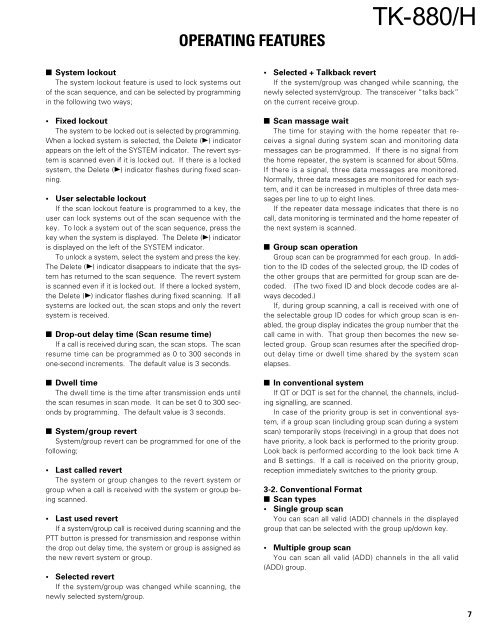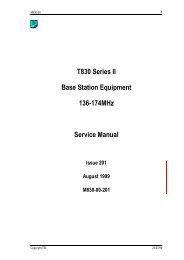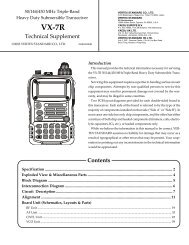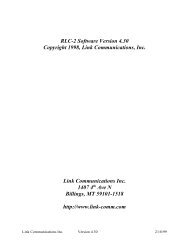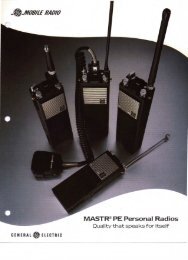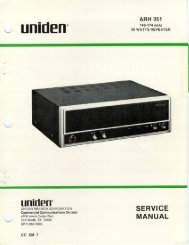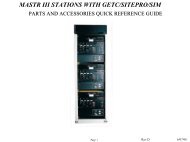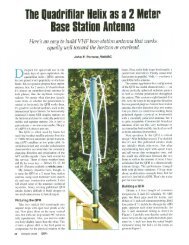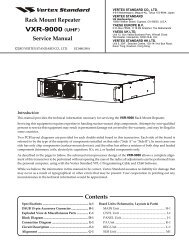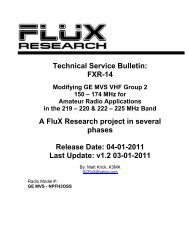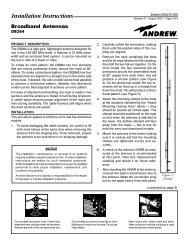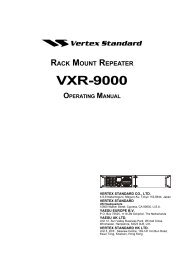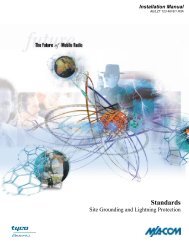TK-880/H (UHF) mobile service manual - The Repeater Builder's ...
TK-880/H (UHF) mobile service manual - The Repeater Builder's ...
TK-880/H (UHF) mobile service manual - The Repeater Builder's ...
You also want an ePaper? Increase the reach of your titles
YUMPU automatically turns print PDFs into web optimized ePapers that Google loves.
OPERATING FEATURES<br />
<strong>TK</strong>-<strong>880</strong>/H<br />
■ System lockout<br />
<strong>The</strong> system lockout feature is used to lock systems out<br />
of the scan sequence, and can be selected by programming<br />
in the following two ways;<br />
• Fixed lockout<br />
<strong>The</strong> system to be locked out is selected by programming.<br />
When a locked system is selected, the Delete ( ) indicator<br />
appears on the left of the SYSTEM indicator. <strong>The</strong> revert system<br />
is scanned even if it is locked out. If there is a locked<br />
system, the Delete ( ) indicator flashes during fixed scanning.<br />
• User selectable lockout<br />
If the scan lockout feature is programmed to a key, the<br />
user can lock systems out of the scan sequence with the<br />
key. To lock a system out of the scan sequence, press the<br />
key when the system is displayed. <strong>The</strong> Delete ( ) indicator<br />
is displayed on the left of the SYSTEM indicator.<br />
To unlock a system, select the system and press the key.<br />
<strong>The</strong> Delete ( ) indicator disappears to indicate that the system<br />
has returned to the scan sequence. <strong>The</strong> revert system<br />
is scanned even if it is locked out. If there a locked system,<br />
the Delete ( ) indicator flashes during fixed scanning. If all<br />
systems are locked out, the scan stops and only the revert<br />
system is received.<br />
■ Drop-out delay time (Scan resume time)<br />
If a call is received during scan, the scan stops. <strong>The</strong> scan<br />
resume time can be programmed as 0 to 300 seconds in<br />
one-second increments. <strong>The</strong> default value is 3 seconds.<br />
■ Dwell time<br />
<strong>The</strong> dwell time is the time after transmission ends until<br />
the scan resumes in scan mode. It can be set 0 to 300 seconds<br />
by programming. <strong>The</strong> default value is 3 seconds.<br />
■ System/group revert<br />
System/group revert can be programmed for one of the<br />
following;<br />
• Last called revert<br />
<strong>The</strong> system or group changes to the revert system or<br />
group when a call is received with the system or group being<br />
scanned.<br />
• Last used revert<br />
If a system/group call is received during scanning and the<br />
PTT button is pressed for transmission and response within<br />
the drop out delay time, the system or group is assigned as<br />
the new revert system or group.<br />
• Selected revert<br />
If the system/group was changed while scanning, the<br />
newly selected system/group.<br />
• Selected + Talkback revert<br />
If the system/group was changed while scanning, the<br />
newly selected system/group. <strong>The</strong> transceiver “talks back”<br />
on the current receive group.<br />
■ Scan massage wait<br />
<strong>The</strong> time for staying with the home repeater that receives<br />
a signal during system scan and monitoring data<br />
messages can be programmed. If there is no signal from<br />
the home repeater, the system is scanned for about 50ms.<br />
If there is a signal, three data messages are monitored.<br />
Normally, three data messages are monitored for each system,<br />
and it can be increased in multiples of three data messages<br />
per line to up to eight lines.<br />
If the repeater data message indicates that there is no<br />
call, data monitoring is terminated and the home repeater of<br />
the next system is scanned.<br />
■ Group scan operation<br />
Group scan can be programmed for each group. In addition<br />
to the ID codes of the selected group, the ID codes of<br />
the other groups that are permitted for group scan are decoded.<br />
(<strong>The</strong> two fixed ID and block decode codes are always<br />
decoded.)<br />
If, during group scanning, a call is received with one of<br />
the selectable group ID codes for which group scan is enabled,<br />
the group display indicates the group number that the<br />
call came in with. That group then becomes the new selected<br />
group. Group scan resumes after the specified dropout<br />
delay time or dwell time shared by the system scan<br />
elapses.<br />
■ In conventional system<br />
If QT or DQT is set for the channel, the channels, including<br />
signalling, are scanned.<br />
In case of the priority group is set in conventional system,<br />
if a group scan (including group scan during a system<br />
scan) temporarily stops (receiving) in a group that does not<br />
have priority, a look back is performed to the priority group.<br />
Look back is performed according to the look back time A<br />
and B settings. If a call is received on the priority group,<br />
reception immediately switches to the priority group.<br />
3-2. Conventional Format<br />
■ Scan types<br />
• Single group scan<br />
You can scan all valid (ADD) channels in the displayed<br />
group that can be selected with the group up/down key.<br />
• Multiple group scan<br />
You can scan all valid (ADD) channels in the all valid<br />
(ADD) group.<br />
7


